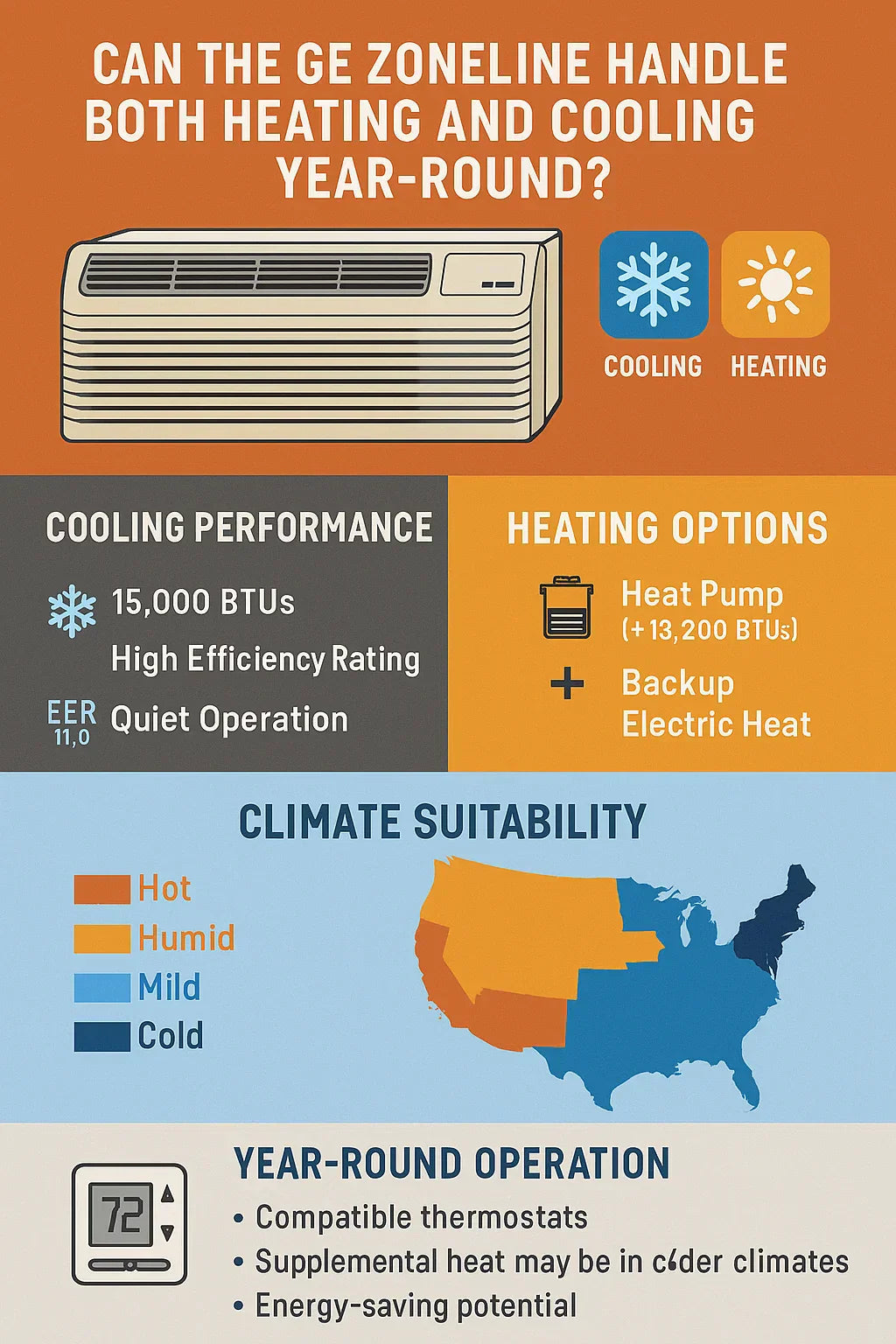For homeowners like Savvy who want comfort in all four seasons without installing a complex or expensive HVAC system, the GE Zoneline 15,000 BTU PTAC unit with Heat Pump (Model AZHS15DCXXA) presents an appealing solution. But a key question remains:
Can this PTAC unit truly handle both heating and cooling year-round—even in colder climates?
In this guide, we’ll break down the heating and cooling capabilities of the GE Zoneline, evaluate its performance across climate zones, explore its smart features, and help you decide if it can stand on its own as a full-season climate control solution.
❄️ Cooling Power: Summer Performance with 15,000 BTUs
Let’s start with what the Zoneline is best known for: cooling.
-
Cooling BTU Rating: 15,000 BTUs/hour
-
Recommended Room Size: 700–800 sq. ft.
-
EER (Energy Efficiency Ratio): ~11.0
-
Fan Speeds: Multiple levels, including quiet mode
-
Programmable Thermostat Support: Yes
-
Dehumidification Mode: Included
The GE Zoneline is more than capable of cooling most mid-sized rooms, including studio apartments, guest suites, hotel rooms, or finished basements. It maintains a steady temperature with minimal noise, especially when set to "quiet fan" or low-speed cycling.
♨️ Heating Capabilities: Heat Pump + Electric Resistance
Where this unit really shines for year-round use is in its dual-mode heating system:
1. 🌬️ Primary Heating: High-Efficiency Heat Pump
-
Heating BTUs (Heat Pump): ~13,200
-
Pulls ambient heat from the outside air
-
Lower energy cost compared to electric resistance
-
Ideal for temperatures down to ~35°F
2. ⚡️ Backup Heat: Electric Resistance Strip
-
Activates when heat pump becomes inefficient
-
Provides consistent warm air regardless of outside temp
-
Draws more electricity than heat pump mode
How it works: The unit automatically switches between heat pump and resistance heat depending on outdoor temperature. This smart control feature ensures comfort without user intervention.
🌍 Climate Zones and Year-Round Use
How well this unit performs year-round depends on where you live.
☀️ Hot/Humid Climates (Florida, Texas, Gulf States)
-
Excellent performance all year
-
Heat pump is rarely stressed
-
Minimal electric backup use
❄️ Cold Climates (Midwest, Northeast)
-
Heat pump works until ~35°F
-
Electric resistance takes over below freezing
-
Well-insulated rooms = better results
📉 Mild Climates (Pacific Northwest, Coastal California)
-
Nearly perfect conditions for a heat pump
-
Little need for backup heat
Bottom Line:
In mild to moderately cold climates, the Zoneline can comfortably provide both cooling and heating for the entire year. In areas with sub-zero winters, it may need help from a space heater or gas furnace during extreme cold snaps.
📊 Smart Controls for Efficient Year-Round Comfort
The GE Zoneline supports advanced energy management features, including:
⌚ Programmable Thermostat Compatibility
-
Works with 7-day digital thermostats
-
Allows for temperature scheduling
-
Optimizes performance across seasons
🤖 Occupancy Sensor Integration
-
Adjusts operation based on room occupancy
-
Ideal for guest suites or rentals
🌡️ Fan Cycling Modes
-
Fan can run continuously or only when heating/cooling
-
Reduces drafts and improves comfort
❄️ Auto Defrost & Heat Activation
-
Heat pump defrosts itself during winter operation
-
Switches to electric heat automatically if needed
🏡 Real-World Applications for Year-Round Use
This unit isn't just for hotels. Homeowners across the country are using the GE Zoneline in creative ways to keep their homes comfortable 365 days a year.
☕️ Studio Apartment in Portland, OR
-
600 sq. ft. space
-
Moderate winters, cool summers
-
Heat pump handles 90% of climate control
🏖️ Sunroom in Atlanta, GA
-
South-facing with large windows
-
Efficient summer cooling
-
Winter heating with some electric assistance
🏠 Guest Suite in Minneapolis, MN
-
Well-insulated 700 sq. ft.
-
Heat pump used until outdoor temps drop below freezing
-
Electric resistance kicks in for bitter cold spells
In all cases, the key to successful year-round use is proper insulation, air sealing, and right-size BTU capacity.
🪨 Maintenance for Long-Term Year-Round Performance
Using the Zoneline in every season means more runtime, so regular maintenance is essential.
💨 Monthly:
-
Clean or replace air filters
-
Wipe down vents
❄️ Pre-Winter:
-
Check condensate drain line
-
Inspect electric heating element (by a professional)
☀️ Pre-Summer:
-
Clean evaporator and condenser coils
-
Test thermostat settings
✅ Pros and Cons of Year-Round Use
| Pros | Cons |
|---|---|
| Heat and cool from one unit | May need backup heat below 20°F |
| Quiet, efficient operation | Needs proper 208/230V outlet |
| Simple installation | Requires sleeve + drainage setup |
| Smart energy-saving features | Not ideal for whole-home use |
📅 Final Verdict: Can the GE Zoneline Work Year-Round?
Yes — for most homeowners, the GE Zoneline 15,000 BTU PTAC with Heat Pump is a strong, reliable option for full-year climate control.
If you live in a moderate to warm climate, this unit can be your sole heating and cooling source. In colder zones, it remains effective with a bit of backup planning.
For spaces like:
-
Guest suites
-
Apartments
-
Converted garages
-
Finished basements
-
Home offices
... the Zoneline provides quiet, consistent comfort 12 months a year with just one compact unit.
Want help determining if the GE Zoneline is right for your climate? Drop your ZIP code and room size, and we’ll help you crunch the numbers.
In the next topic we will know more about: How Quiet Is the GE Zoneline? Noise Ratings, Fan Settings & Real-World Reviews







